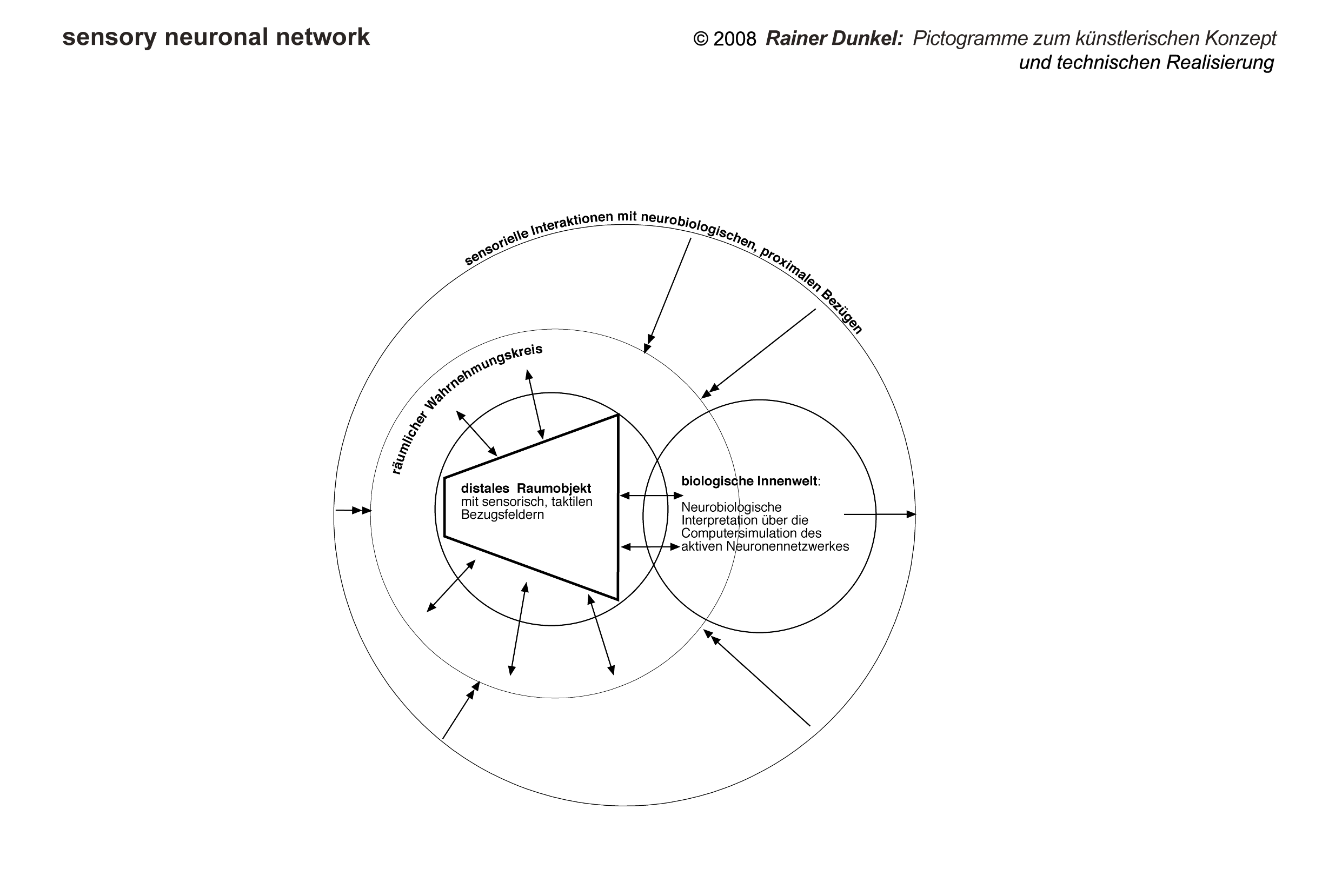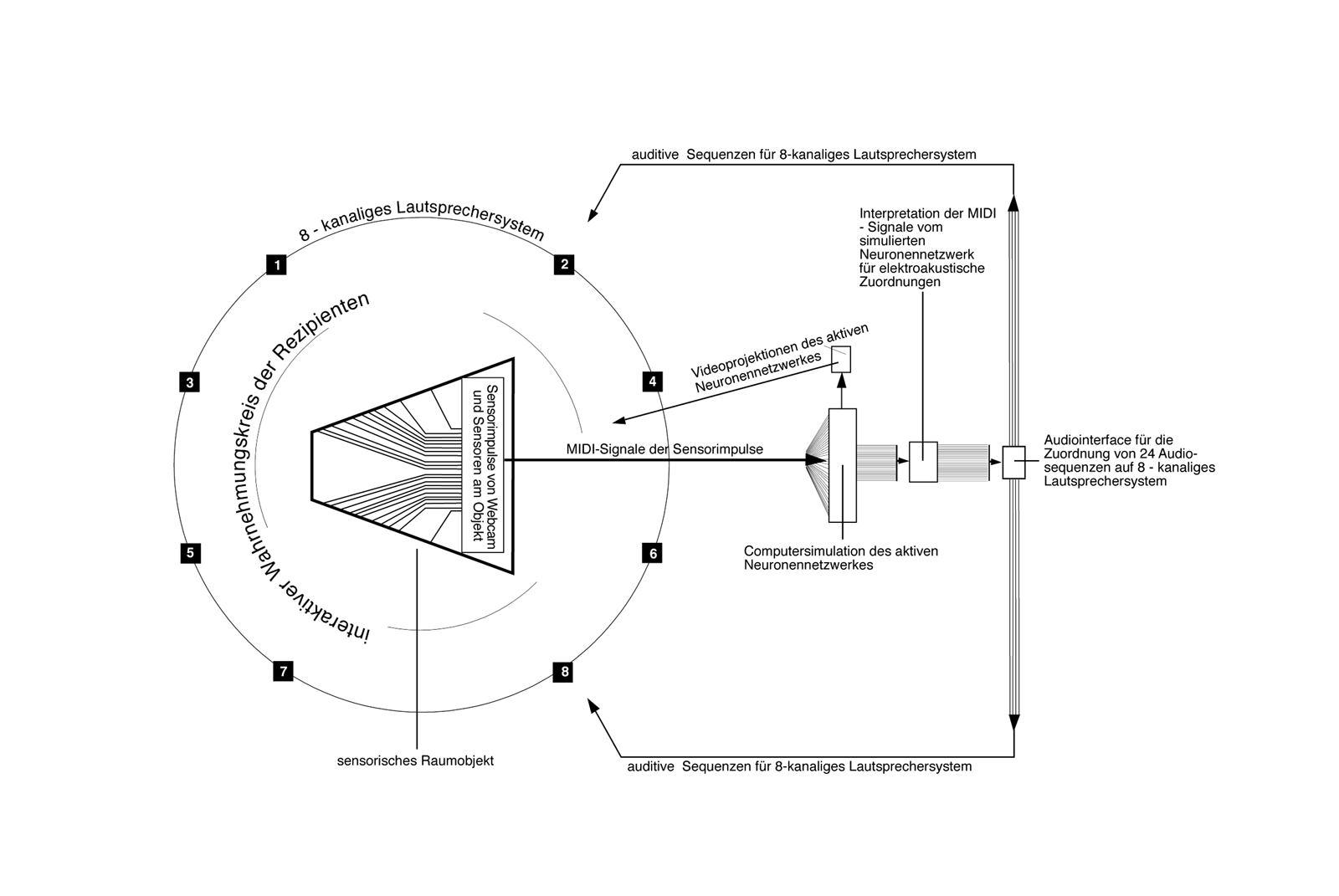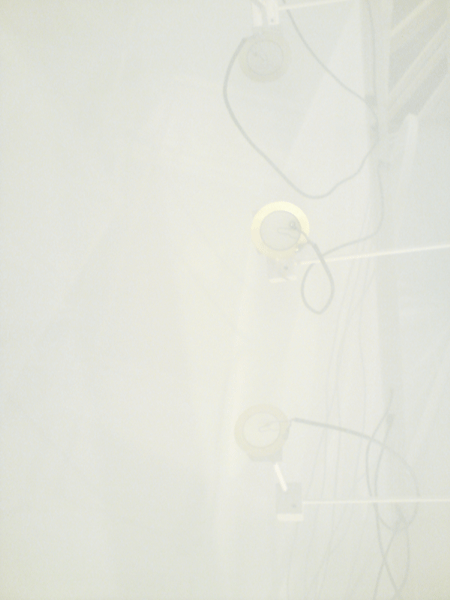

sensory neuronal network - (eine sensorielle-interaktive Installation)
von
rainer dunkel und benjamin staude
YouTube-Link: snn- Video Full HD: Galerie Herold, 2015 Bremen
Das Konzept dieser interdisziplinären Installation ist es, neurozelluläre Interaktionen von Neuronen sensoriell erfahrbar zu machen. Raumobjekt und Implementierung sind neuroorganisches Modul und Schnittstelle für audiovisuelle Interaktionskorrelate, die exogene und endogene Identitätsmomente in einem konstruktivistischen Kontext eröffnen.
Interdisziplinäre Projektarbeit:
Rainer Dunkel - sensorisches Raumobjekt und audiovisuelle Projektionen
Dr. Benjamin Staude - Neurobiologische Netzwerksimulation mit audiovisuellen Darstellungen
initiiert und unterstützt von dem Neurowissenschaftler Prof. Dr. Stefan Rotter (Leiter des Bernstein Zentrums Freiburg)
Der Künstler Rainer Dunkel und der Neurowissenschaftler Dr. Benjamin Staude beleuchten in ihrer interdisziplinären Arbeit "Sensory Neuronal Network” die ästhetischen Korrelate neuronaler Dynamik. Ein neurozelluläres System ist organischer Initiator des korrelativen (kollektiven) Geschehens. Räumliches Substrat der Auseinandersetzung ist eine kubistische Rauminstallation, die durch taktile Sensoren als Eingangsmodul einer neuronalen Netzwerksimulation fungiert. Die dynamischen Aktivitätsmuster dieser der menschlichen Grosshirnrinde nachempfunden Simulation bilden die Basis der künstlerischen Auseinandersetzung.
Durch interaktive Visualisierung und Vertonung von Neuronenimpulsen versuchen Dunkel und Staude sich der wohl faszinierendsten wissenschaftlichen Frage unserer Zeit zu nähern: Wie entstehen in unserem Gehirn aus Billiarden von Einzelimpulsen individueller Nervenzellen einheitliche Geisteszustände wie Wahrnehmung, Emotionen oder Bewusstsein? Fern davon, auf diese Fragen klare Antworten formulieren zu wollen, setzt sensory neuronal network vielmehr auf eine sensorielle Konfrontation des Besuchers mit der neuronalen Basis seiner Existenz in einer abstrakt- verkörperten Umwelt.
Dem Besucher präsentiert sich “Sensory Neuronal Network" als interaktive, multi-sensorische Rauminstallation. Die taktilen Elemente des kubistischen Objektes, das sowohl Input- Modul als auch Output- und Projektionsfläche für die Berührungen der Besucher ist, befreit ihn von einer rein perzeptiven Rolle: Einem Forscher gleich, der einzelne Nervenzellen im Labor stimuliert, kann er dem Effekt kleinster Reize auf die Dynamik des Systems nachspüren. Diese “spielhafte” Auseinandersetzung erlaubt es dem Besucher, sich der biologischen Grundsubstanz seines psychologischen Selbst in ästhetischen Kategorien zu nähern.
Das konstruktivistische Objekt von Rainer Dunkel ist sowohl rezeptorisches Modul als auch Projektionsfläche, und generiert die implementierte Simulation von Neuronenaktivität. Die sensorische Konstruktion öffnet abstrakte Bezüge zu den kleinsten neuronalen Impulsen: Von Raum-Fläche-Linie zu Punkt ist hier thematisierte Deduktion zu der multiplen Vielheit kleinster neuroorganischer Elemente und deren Bindungen. Dynamisch-selbstregulierte Neuronenspikes auf dem sensorischen Objekt und die modifizierte Metaebene der audiovisuellen Bild- und Tonimpulse, entwerfen zum ersten Mal eine neurogenerative Konstruktion.
Sensory neuronal network thematisiert als multisensorielle Installation neurozelluläre Interaktionen als neurophysiologische Vorraussetzung für Wahrnehmungsprozesse, die zwischen distalen Umgebungsraum und proximalen, sensoriellen Reizen vermitteln. In diesem Kontext entwirft die Installation ein räumliches Model von korrelativen Ebenen.
Das Herz der Installation bildet die Echtzeitsimulation eines balancierten, rekurrenten neuronalen Netzwerkes von 400 integrate-and-fire Neuronen. Durch die adaptiviten Reaktionen des Netzwerkes auf sensorische Input-Reize bildet die direkte audiovisuelle Repräsentation seiner dynamischen Spike-Aktivität eine dynamisch-interaktive Ebene, die den Besucher die hochdimensionale und wissenschaftlich schwer quantifizierbare Komplexität neuronaler Dynamik unmittelbar erfahren lässt. In Analogie zu wissenschaflichen Modellen hierarchisch höherer Entscheidungs- und Bewusstseinsprozesse triggern ausgewählte “read-out’-Neurone des Netzwerkes zusaetzlich visuelle und auditorische Repraesentationen.
Das gegenständliche Raum-Objekt, dessen formale Gestaltung Analogien zu Zellkaskaden sensorischer Sensibilität und gedanklich konstruierten Projektionen erlaubt, formuliert konstruktivistisch-abstrakte Ebene. Unter Aspekten eines abstrakt-sensorischen Mediums generiert das Raumobjekt neuroorganismische Dynamiken, und reguliert so die audiovisuelle Netzwerkprojektion als einen authentischen Umgebungsraum.
Die künstlerische Arbeit ist über die Reflexionen der wissenschaftlichen Aussagen hinaus, Fragestellung nach Wechselbeziehungen zwischen Neuro- Organismus und sensoriellem Empfinden. „Es interessiert mich insbesondere eine proximale Sensibilität und die zugrunde liegenden interaktiven Faktoren von Wahrnehmungsprozessen, und Empfindungsbezüge zwischen dem neuronalen Selbst und eine Synthese für Identitätsempfinden als abstraktes Envirement.“ Die statische und objektive Raumkonstruktion ist ein sensorisch, vermittelndes Medium für individuelle Berührungspunkte und deren neurosensiblen Reflexionen. Das abstrakte System ist eine räumlich-gedachte Faltung quadratischer Segmente die sich in den räumlichen Positionen variabler Perspektiven durchdringen. Die Sensoren sind Bestandteil des räumlichen Systems, deren aktivierten Signale ausschlaggebend sind für das Gesamtbild des multiplen Raum-Korrelats. Als ein konstruktivistisches Medium entwirft das räumliche Objekt „kubusensorielle Dimension“. Die neurobiologische Simulation entwirft darin wissenschaftliche Parameter für die sensorielle Erfahrungswelt. Rainer Dunkel 16.03.2011 Neurozelluläre Aktivitätszustände sind sowohl ästhetischer Aspekt der künstlerischen Dimension als auch inhaltliche Fragestellung nach Wechselbeziehungen zwischen distalen Umgebungsreizen und inneren Erfahrungsmustern proximaler Sensibilität. Die Rezipienten der räumlichen Installation aktivieren die multiple Sensorik der abstrakten Konstruktion, und lösen dadurch Impulse für die neuronale Netzwerksimulation aus, die darauf reflexiv reagiert. Die elektronische Sensorik am Objekt ist eine abstrakte Analogie zur neurobiologischen Sensorien aktiver Organismen. Über die aktiven Impulse (auch sogenannte Modulatoren) wird das simulierte Neuronennetzwerk stimuliert, welches sich zusätzlich adaptiv selbst modifiziert. Es reagiert unmittelbar mit elektroakustischen und visuellen Output-Projektionen. Die sensorische und gegenständliche Raum-Konstruktion von Rainer Dunkel verbindet den situativen Prozess der sensoriellen Bezüge zu neuronalen Reizen. Die Abstraktion ist gleichzeitig konstruiertes Medium zwischen äußeren und inneren Erfahrungsmustern der neuronalen Realität: Unser adaptiv neurozelluläres System der Wahrnehmung erzeugt sensorische, zelluläre Impulskaskaden und generiert komplexes Bewusstsein mit dem kognitiven Phänomen der Selbstreflexion. In diesem Kontext ist die sensorische Konstruktion der Installation eine reflexive Schnittstelle zwischen abstrakten Aspekten und neurobiologischen Impulsen des entwerfenden Bewusstseins. Über die Sensorik der bildnerischen Abstraktion und der rechnergestützten neurobiologischen Simulation soll für den Betrachter ein distaler Zugang zu sensiblen Aspekten neurobiologischer Bewusstseinsprozesse eröffnet werden. Zwischen dem möglichen Grad einer neuronalen Identität und der bildnerisch-statischen Konstruktion interagieren die individuellen Impulse mit audiovisuellen Projektionsvariablen der adaptiven Netzwerksimulation. Die Netzwerkaktivität repräsentiert proximale Ereignisse einer neurorezeptorischen Innenwelt, und ist Output- Parameter für die emotional-sensoriellen Ebenen des globalen Wahrnehmungsraumes. Abstrakte Konstruktion, neurozelluläre Netzwerkdynamiken und multisensorielle Impulse im Raum, durchdringen und überlagern sich in einem sensoriellen Korrelat.
"Die Intention dieses Projektes ist es, eine Perspektive neuronaler Interaktionen im strengsten Sinne des Wortes, anzubieten, um eine zugängliche Verbindung über Computer-Simulationen mit der neurobiologischen 'inneren Welt' zu etablieren, die auf Erkenntnisse der neurowissenschaftlichen Forschung basiert. Denn unser Projekt ist jetzt nur in der Lage, eine solche Perspektive anzuregen, aber nicht eine wissenschaftliche Methode zu beweisen. "(Rainer Dunkel)
Die Installation ist zwar noch nicht in der Lage, ein kognitiv- erkennendes Selbst zu simulieren, es ist aber in diesem Projekt gelungen, in den multiplen, korrelativen Überlagerungen audiovisueller und gegenständlicher Raumschichten neuronale, sequenzielle Zustände zu erzeugen, die in der Lage sind, in einem autopoeitischen Gesamtzustand zu oszillieren. Neue Feedback-Dimension ist die neurowissenschaftliche- deduktive Abbildung eines Neuronenorganismus, dessen Signale über induktiv sensorische Berührungen innere Welt als äußere Abbildung repräsentieren. Die audiovisuellen Sequenzen beinhalten Aspekte neurozellulärer Wahrnehmungsprozesse in einem abstrakten Vergleich, denn der Besucher wird im Korrelat der Raumsituation dazu angehalten, sensuelle Vergleiche seiner Aufmerksamkeit und Wahrnehmung zwischen den aktiven Sequenzen herzustellen, zu differenzieren und zu binden, so wie das neurozelluläre System biologisch auch verarbeitet. Deswegen scheint sich die Gesamtinstallation mit seinem Korrelat an Schichten, Überlagerungen und Bindungen einer objektiven Beschreibarkeit zu entziehen. Das entspricht aber dem neuro-dynamischen Zustand des Bewusstseins und eines kognitiven Selbst.
Die Gegenüberstellung von wissenschaftlich-abstraktem Denken und körperlich-sinnlicher Erfahrung in künstlerischer Form bietet die Chance, die Wissenschaftler selbst auf neue Weise mit Aspekten ihrer eigenen Arbeit zu konfrontieren. Folglich wird der Raum der Installation zu einem "neutralen Boden", auf dem Wissenschaftler und Mitglieder der Öffentlichkeit die Funktion ihrer Gehirne als gleichrangig betrachten. Begeistert von der ungewöhnlichen Form und einer Erfahrung, die für beide Gruppen neu ist, ermöglicht die Installation einen Dialog.
Die Reduktion komplexer Fragestellungen auf das Wesentliche ist die Essenz sowohl wissenschaftlicher als auch künstlerischer Arbeit. Ein charakteristischer Unterschied zwischen den Disziplinen besteht in den Kriterien, nach denen das “Wesentliche“ gefiltert wird: wo die Naturwissenschaft bestrebt ist, durch Peer-Review-Prozesse maximal transparente und objektive Qualitätskriterien zu etablieren, zielt die zeitgenössische künstlerische Auseinandersetzung rein auf das subjektive Erleben im Betrachter. Bei diesen grundlegenden Differenzen verwundert es nicht, daß diese beiden Disziplinen ungeachtet ihrer vergleichbaren Zielsetzung, heute kaum von einander profitieren.
Die Installation sensorisch-neuronales Netzwerk wurde in enger Zusammenarbeit mit dem Bernstein Center in Freiburg entwickelt. Ihr Direktor, Prof. Dr. Stefan Rotter von der Universität Freiburg, bot Veranstaltungsabende mit wissenschaftlichen Vorträgen an, in denen er grundlegende Fragen der modernen computergestützten Hirnforschung beschreibt. Eine Besonderheit der Präsentation ist, dass sich der Inhalt, analog zu den Prozessen in neurobiologischen Netzwerkkollektiven, selbstregulierend verändert: Besucherimpulse werden in einem interaktiven Modellstimulationsmodell eingespeist und beeinflussen so den Verlauf der Vorlesung.
Die Installation "sensorische neuronale Netze" wurde auf der Bernstein Konferenz bc11 der Universität Freiburg vom 4. bis 6. Oktober 2011, Deutschland, erstmals der Öffentlichkeit vorgestellt.
2014 Berlin, Galerie MEINBLAU
2015 Bremen, Galerie Herold
Bitte kontaktieren Sie "sensorisches neuronales Netzwerk" unten:
mail: HYPERLINK "mailto:web@atelier-rainerdunkel.de" web@atelier-rainerdunkel.de
homepage: HYPERLINK "http://www.atelier-rainerdunkel.de/rd_html/s11-html/rd_s11c.html" http://www.atelier-rainerdunkel.de/rd_html/s11-html/rd_s11c.html
English:
sensory neuronal network - (a sensorial-interactive installation)
from
rainer dunkel and benjamin staude

The concept of his interdisziplinary installation is to make neurocellular interactions of neurons perceptible to the senses. The spatial object and implementation are the neuroorganic module and the interface for audiovisual interaction correlates, which open up exogenous and endogenous identity moments in a constructivist context. .
Interdisciplinary project work:
Rainer Dunkel - sensory space object and audiovisual projections
Dr. Benjamin Staude - neurobiological network simulation with audiovisual representations
initiated and supported by the neuroscientist Prof. Dr. Stefan Rotter (Head of the Bernstein Center Freiburg / Germany)
The artist Rainer Dunkel and neuroscientist Dr. Benjamin Staude illuminate in its interdisciplinary installation "sensory neuronal network" correlates of aesthetic neuronal dynamics. Sensory stimulated activity pattern of the human cerebral cortex modeled simulation form the basis of artistic confrontation. A neurocellular system is itself an organic initiator of correlative (collective) events.
Through interactive visualization and tone settings of neuronal impulses Dunkel and Staude try the most fascinating scientific issue of our time to approach: How do our brains out trillions of individual pulses of individual nerve cells-uniform states of mind such as perception, emotions, or consciousness? Far from trying to formulate clear answers to these questions, sensory neuronal network is rather an aesthetic confrontation of the visitor with the neural basis of its existence as an abstract -embodied envirement.
"Sensory Neuronal Network" presents itself to the visitor as an interactive, multi-sensory room installation.The tactile elements of the cubist object, which is both the input module and the output and projection surface for the visitor's touch, relieves him of a purely perceptive role: Like a researcher who stimulates individual nerve cells in the laboratory, he can trace the effect of the least stimuli on the dynamics of the system.This "playful" engagement allows the visitor to approach the biological ground substance of his psychological self in aesthetic categories.
So the constructivist object of Rainer Dunkel, both as rezeptive module and as projection surface, generates simulated neuronal activity. Sensory design opens abstract references to the smallest neural impulses: From space-plane-line to-point here is themed deduction to the smallest multiple multiplicity neuroorganic elements and their compounds. Dynamic self-regulating neurons spikes on the sensory object and the modified meta-level of audiovisual image and sound impulses, design for the first time a neurogenerative construction.
As a multi-sensorial installation, sensory neuronal network addresses neurocellular interactions as a neurophysiological prerequisite for processes of perception that mediate between the distal environment and proximal sensory stimuli. In this context, the installation designs a spatial model of correlative levels.
The heart of the installation is the realtime-simulation of a balanced recurrent neural network of 400 integrate-and-fire neurons. By the adaptive reaction of the network to sensory input-stimuli, the audiovisual representation of its dynamical spike-activity creates a dynamic-interactive layer, allowing a direct sensual experience of the high dimensional complexity of neuronal dynamics. In analogy to scientific models of higher conscious- or decision-making processes, selected “read-out’-neurons trigger additional visual and auditory representations.
The objective space object, whose formal configuration embodies analogies to cell-cascades of sensory sensitivity and thought-constructed projections, formulates a constructivist-abstract level. Under aspects of an abstract-neuronal medium, the spatial object generates neuroorganismic dynamics, regulating the audiovisual network projection as an authentic environment space.
The artistic work is beyond the reflections of scientific statements, the question of interrelationships between neuroscientific Organism and sensory perception. „I’m particularly interested in proximal sensitivity and the underlying interactive factors of Perceptual processes, and sensory relationships between the neural self and a synthesis of the sense of identity as an abstract envirement. "
The static and objective spatial construction is a sensory, mediating Medium for individual points of contact and their neurosensible Reflections. The abstract system is a spatially-imaginary folding square segments which permeate themselves in the spatial positions of variable perspectives.
The sensors are part of the spatial Systems whose activated signals are crucial for the Overall picture of the multiple space correlate. As a constructivist medium, the spatial object designs "Cubic sensorial dimension". The neurobiological simulation designs scientific parameters for the sensorial world of experience.
Neurocellular activity states are both aesthetic aspect of artistic dimension as well as substantive questions Interactions between distal environmental stimuli and internal ones Experience patterns of proximal sensitivity.
The recipients of the spatial Installation activate the multiple sensors of abstract construction, and thereby trigger impulses for neural network simulation which reacts reflexively. The electronic sensors at the Object is an abstract analogy to the neurobiological senses more active Organisms. About the active impulses (also called modulators) stimulates the simulated neural network, which in addition adaptively self-modified. It reacts directly with electro-acoustic and visual output projections. The sensory and representational space construction by Rainer Dunkel connects the situational process of sensorial relations neural stimuli. Abstraction is at the same time a constructed medium between outer and inner experiential patterns of the neural Reality: Our adaptive neurocellular system of perception generates sensory, cellular impulse cascades and generates the complex consciousness with the cognitive phenomenon of self-reflection. In this context, the sensory construction of the installation is a reflexive interface between abstract aspects and neurobiological impulses of the designing consciousness. About the sensors of artistic abstraction and the computer-aided Neurobiological simulation is intended to provide the viewer with a distal access to sensitive aspects of neurobiological awareness processes. Between the possible degree of neural identity and visual-static construction, the individual impulses interact with audiovisual projection variables of the adaptive network simulation. The activity of the network represents proximal events of a neuro-receptory inner world and is the output for the sensory layer of perceptive space and distal envirement. Abstract construction, nerucellular dynamics and multisensory impulses in space interpenetrate and superimpose in a sensory correlate.
“The intention of this project is to offer a perspective on neuronal interactions that is accessible in the strictest sense of the word, establishing a connection with the neurobiological ‘inner world’ through computer simulations that are based on the insights of neuroscientific research. For now, our installation is only able to stimulate such a perspective, but not to found a scientific method.” (Rainer Dunkel)
Although the installation is not yet able to simulate a cognitively recognizing self, in this project it has been possible to generate neural, sequential states in the multiple, correlative overlays of audiovisual and representational spatial layers that are capable of to oscillate in an overall autopoeitic state. A new dimension of feedback is the neuroscientific deductive mapping of a neuron organism whose signals represent the inner world as an external image via inductively sensory contacts. The audiovisual sequences include aspects of neurocellular processes of perception in an abstract comparison, because the visitor, in the context of the spatial situation, is required to produce, differentiate and bind sensory comparisons of his attention and perception between the active sequences, just as the neurocellular system also biologically processes. Therefore, the overall installation, with its correlate to layers, overlays, and bindings, seems to elude an objective description. But this corresponds to the neuro-dynamic state of consciousness and a cognitive self.
The juxtaposition of scientifically-abstract thought and physically-sensual experience in an artistic form offers the chance to confront the scientists themselves in new ways with aspects of their own work. Consequently, the space of the installation becomes “neutral ground” on which scientists and members of the public face the function of their brains as equals. Fostered by the unusual form and an experience that is new for both groups, the installation enables them to enter a dialog. “Reducing complex questions to their basics is the essence of scientific and artistic work alike. One characteristic difference between these disciplines lies in the criteria to filter the aforementioned ‘basics’: Whereas the natural sciences strive to establish maximally transparent and objective criteria, e.g. by the peer-review process in publishing, the contemporary artistic exploration aims at subjective experiences by the recipient. Considering these fundamental differences, it is not astonishing that these two disciplines hardly benefit from each other nowadays, irrespective of their comparable goals.” (Dr. Benjamin Staude)
The installation sensory neuronal network is developed in close cooperation with the Bernstein Center in Freiburg. Its director, Prof. Dr. Stefan Rotter from the University of Freiburg offered event-evenings with scientific lectures, in which he describes basic questions of modern computerized brain research.
A special feature of the presentation is that the content,
analogous to the processes in neurobiological network collectives,
self-regulating modifies: pulses of visitors in an interactive
simulation model fed and thus influence the course of lecture.
The installation "sensory neuronal networks" was presented to the public for the first time at this Bernstein Conference bc11 in University of Freiburg, Oct.4-6th. 2011, Germany.
2014 Berlin, gallery MEINBLAU
2015 Bremen, gallery Herold
